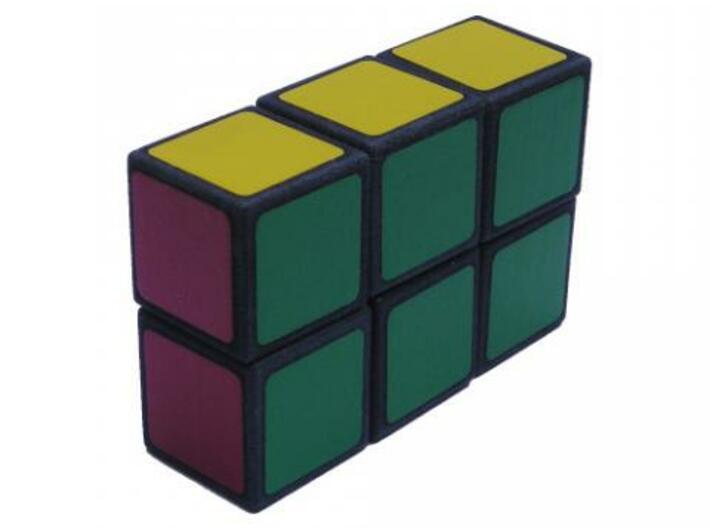Recently I made a 1x2x3 Rubik's cuboid (example here) for my little brother, thinking that the number of possible permutations of the cuboid would be small enough that he could solve it simply by twisting randomly. Sure enough, he can (as can any one else). However, I wanted to know the exact number of possible permutations this little cuboid can have, and an extensive internet search revealed nothing. I found sites capable of giving me the number of permutations of any regular (nxnxn) Rubik's cube, but giving me the formula used or any information about irregular cuboids. So, what formula can I use to calculate the number of possible permutations in any irregular cuboid, and more specifically the 1x2x3?
Also, forgive the elementary nature of this question. While most mathematicians would most likely find this combinatorics problem simple, I have never studied probability and cannot find a simple solution to this online; therefore I deemed this question pertinent to Math SE.

Best Answer
Assuming that only complete $180^\circ$ turns are allowed, the answer is $48$. Here is an attempt at an intuitive solution.
We can rotate the pair of cubes on the left, the pair on the right, the trio on top, or the trio at the bottom. Notice that the last two moves are (for our purposes) the same. So we can say there are only really three legal moves, all of which are their own inverses.
Imagine that you glue the middle of the base to a pedestal. Now only five cubes move at all, and the one on top in the middle can only rotate $180^\circ$ in place. This leaves four outer cubes which can change location. By labelling them 1,2,3,4 we can think of them as though they were next to each other in a line, so that the pairs (1,2), (2,3), and (3,4) start as neighbours.
Each of the three legal moves swaps two neighbouring cubes. Rotation of the trio on top also has the effect of rotating the top middle cube by $180^\circ$.
Thus the three legal moves can be expressed as the transpositions $(1,2), (2,3)$ and $(3,4)$, which suffice to generate any permutation of $(1,2,3,4)$. This means that the positions of the four outer cubes can be permuted freely. Because of the linearity, and the fact that only "neighbouring" cubes move simultaneously, there is effectively only one sequence of motions through space which any of these four cubes can take from one location to another, and so each outer cube's orientation is determined by its location. This gives $4!=24$ permutations of the numbered cubes.
However, it is possible to flip the top central cube while returning the outer cubes to their initial positions. The sequence top, left, top, left, top, left does this. The consequence is that there are actually $4!\cdot 2=48$ permutations.
Part II. As an extension, consider a version of the toy in which we can turn the top trio $90^\circ$ and then rotate individual outer cubes in that intermediate position. If we are only interested in cuboid final positions, this turns out to be only a slightly different situation.
First, notice that if you turn the top $90^\circ$ and then separately rotate cubes 2 and 3 into the lower level to create a cross, it then becomes possible to rotate the top central cube freely. Second, if instead you rotate cubes 1 and 4 into the upper level, then rotate the upper cross, it is possible to restore the cuboid shape while revealing the unpainted faces of the fixed cube at the bottom. Third, the fact that the restoration of the cuboid shape must hide the unpainted faces of the outer cubes ensures that their orientation is still effectively determined by their location relative to the rest of the cuboid.
Thus the outer cubes are still being permuted in a simple way; the fixed cube can show either its unpainted or its painted vertical faces (west-east or north-south, say); and the top central cube can show any vertical face at the front (south or west, say); but we might not be able to distinguish the unpainted faces which appear together, and this adds complications. If we can tell apart the unpainted faces, the result is $4!\cdot 8=192$ permutations.
Now, what happens if we are only interested in the pattern of colours, and consider unpainted faces to be the same colour? In $96$ permutations, the fixed cube is showing its painted sides; in half of those, the top central cube is showing its painted sides, and in the other half, its unpainted sides. In the other $96$ permutations, the fixed cube is showing its unpainted sides; in half of those, the top central cube is showing its painted sides, and in the other half, its unpainted sides. Because of the symmetries already found, we can sum $48(1+\tfrac12+\tfrac12+\tfrac14)$ $=48+24+24+12$ to get $108$ different colour patterns.